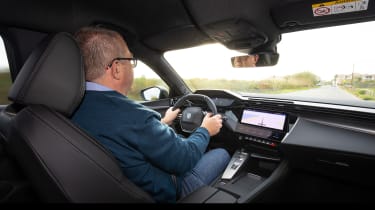New Peugeot E-308 SW estate review: EV wagon with real polish and few rivals
Peugeot has entered the electric estate car market with the E-308 SW, and made a very good fist of it

Verdict
We’re not sure that we’d flash the extra cash on a GT version, even if the finance-deal walk-up may increase its appeal. But the Peugeot E-308 SW is a well-resolved and practical EV with a premium finish – a car that certainly merits consideration in what remains a very young market for zero-emissions estates. Its EV powertrain delivers sensible performance and solid range – and while slicker rivals will probably arrive in the next 12 to 18 months, for now, this has to be one of the best electric load-luggers out there.
The Peugeot 308 was one of the first family hatchbacks to commit to an all-electric version, back in 2021. But the model’s estate variant has remained petrol only. That changes now, with the arrival of the new E-308 SW, a fresh entry into the comparatively rarified market of all-electric estates.
Indeed, you’d have to say that beyond the closely related Vauxhall Astra Sports Tourer and the desperately dull but worthy MG5, there are no obvious rivals for the E-308 SW. And that could well remain the situation for some time, with more expensive zero-emissions wagons due over the next 18 months, but the likes of Skoda not planning to enter the more mainstream arena until 2026.
Used - available now
The E-308 SW arrives as part of a useful update of the electric 308 itself – albeit one that really only brings it in line with swathes of other models recently upgraded by the wider Stellantis Group. There’s a slightly larger battery – up from 50kWh (45kWh usable) to 54kWh (51.5kWh usable). The front-mounted motor has changed too, so it now offers up to 154bhp and 270Nm of torque.
You now get a heat pump by default – useful for maximising range during the UK’s colder months – and while Peugeot is still finalising the numbers, the revised battery chemistry and more efficient motor should deliver north of 240 miles of range. Three-phase charging comes as standard – although 11kW compatibility is more useful in continental Europe than the UK – and 100kW DC charging can take the E-308 SW from 20 to 80 per cent of its charge in less than 25 minutes.
These are respectable figures rather than stellar ones, but the good news is that the regular 308 SW’s well-resolved dynamic package has not been ruined by the extra mass of a battery-electric powertrain. There’s surprising heft to the steering – all the more so, given the smaller steering wheel that sits at the heart of Peugeot’s i-Cockpit layout – and the E-308 SW responds crisply to inputs. On Peugeot’s Spanish launch route we found it easy to point the nose at corners, reassured by good lateral grip and fine body control. If anything, it’s perhaps a bit more agile than an estate car really needs to be.
This would be a problem if ride comfort had been badly compromised but thankfully, it hasn’t. There are still a few classic traits of the car’s EMP2 underpinnings, such as an inability to soothe out really sharp, high-frequency inputs – basically where the car runs out of suspension travel, particularly at the rear. But this happens relatively rarely, and the rest of the time there’s a good mix of compliance and composure. It’s a more complete package dynamically than the MG5, we’d argue.
Performance is brisk rather than rapid, for as with other Stellantis models, the more powerful motor actually defaults back to the previous output, around 134bhp, when you’re in the E-308 SW’s normal mode. To get the full punch you’ll need to flick the car into Sport – and even if you do this, there’s a slight delay between standing on the throttle pedal and the system delivering that traditional EV shove. It’s far from a deal breaker – if anything, it makes the E-308 SW feel a little more like a combustion-engined car, which may well have been the intention – but it does mean that, even in its most potent configuration, the powertrain responds better to a smooth approach than genuine commitment.
There’s a revised range structure for the E-308 SW. It starts with Allure, which brings 18-inch alloy wheels, heated front seats and steering wheel, a reversing camera and Peugeot’s double-screen infotainment and instrument display. Step up to GT and you’ll add matrix-LED headlights, sports seats finished in Alcantara, exterior-styling flourishes and a fancier dashboard incorporating a projection-based 3D display.
It’s that version we’re trying here, and while it all still feels decently premium inside – with Stellantis’s trademark piano-black finish moved to areas where you won’t touch it – and inevitably scratch it – we’re not sure we’d spend the extra cash on the additional tech. The 3D display is at best a gimmick, with information overlaid in a semi-transparent fashion, on top of the regular info. It smacks of two elements trying to do a job that a single, less fussy interface could manage by itself.
There are physical shortcut buttons on the dashboard, positioned beneath a smaller touch panel where you’re able to place widgets or shortcuts to commonly requested features, such as heating or ventilation. It’s still not quite as good as having a regular switch or dial for temperature and fan speed, but it’s a move back in the right direction compared with Peugeot’s recent efforts in this area. The interface on the screen itself is clear enough, although we’d suggest the animated transitions between screens are there to disguise lag; they certainly don’t enhance usability.
The rear cabin has generous amounts of knee and leg room, but taller passengers may find that the rakish roofline makes it tricky to get in and out without clipping the header rail. The boot capacity is 548 litres, the same as in the hybrid 308 SW, rising to 1,574 litres if you lower the rear seats. There’s a low lip, making it easy to lug heavy items into the loadspace, and while there’s not much space beneath the floor, you could squeeze a charging cable under there to keep the boot floor clear for luggage.
Peugeot has yet to confirm definitive UK prices but the smart money suggests it will cost around £1,000 more than the equivalent E-308 hatchback, giving it a starting figure of around £41,000. And the GT tested here, without options, would cost you around £43,000. Finance deals will cushion the blow, of course, but in an era where manufacturers need to make EV motoring more affordable, these numbers still look punchy.
| Model: | Peugeot E-308 SW GT 54KWH 156 |
| Price: | £43,250 (est) |
| Powertrain: | 54kWh battery, 1x e-motor |
| Power/torque: | 154bhp/270Nm |
| Transmission: | Single-speed auto, front-wheel drive |
| 0-62mph: | 9.3 seconds (est.) |
| Top speed: | 93mph (est.) |
| Range: | Up to 248 miles (est.) |
| Charging: | 100kW (20-80% in 25min) |












